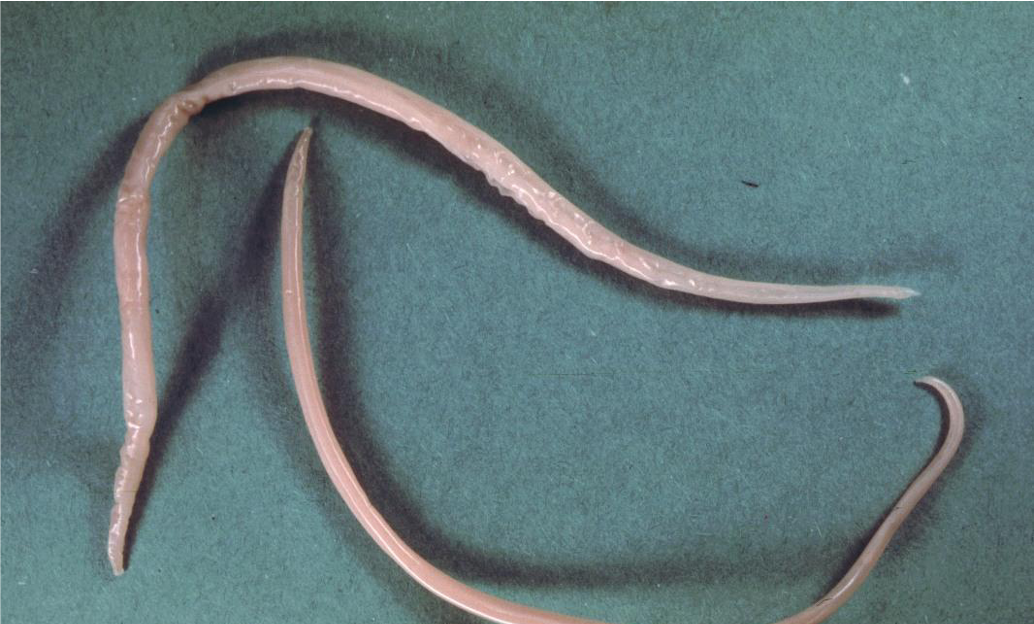
Ascaris suum (Pig roundworm, AG01) Assembly and Gene Annotation
NOTE: The genome sequence and annotation for A. suum are updated in Ensembl Metazoa infrequently. For the latest genome and annotation, please visit WormBase ParaSite.
About Ascaris suum
Ascaris is a genus of parasitic nematodes that can cause infections in humans and pigs. The roundworm Ascaris suum, is an intestinal parasite of pigs causing ascariasis and it has been characterised as the most damaging worm of swine. It is also known as the “large roundworm of pig”. Ascariasis is a soil-transmitted infection caused by ingesting the eggs of Ascaris suum. After a maturation process which takes place in the intestines, liver and lungs, the larvae will get swallowed again and will end up in the small intestine where the adult worms will emerge. Ascariasis in pigs is causing an increased feed to gain ratio and liver condemnation, while the migration of larvae through the lungs has been associated with secondary bacterial infections and cute respiratory symptoms in pigs. The eggs produced by the adult worms, which end up in the feces, and are extremely resistant to environmental conditions and disinfectants, remaining infective in the environment for years.
A. suum is closely related to A. lumbricoides, the human large roundworm parasite, one of the most common human parasitic infections in the world. Cross infections of A. suum to humans and A. lumbricoides to pigs have been reported.
Picture credit: Alan R Walker Creative Commons Attribution 3.0 via Wikimedia Commons (Image source)
Assembly
The A. suum genome has been sequenced by the Davis laboratory at the University of Colorado as described by Wang et al. (2017) . The version presented here is an assembly update, superseding one described in Wang et al. (2012)
Annotation
The gene predictions were made by the Davis laboratory at the University of Colorado based on the output of TransDecoder . A correction was submitted by authors in 2018 for the release 11 of WormBase ParaSite.
References
- Comparative genome analysis of programmed DNA elimination in nematodes.
Wang J, Gao S, Mostovoy Y, Kang Y, Zagoskin M, Sun Y, Zhang B, White LK, Easton A, Nutman TB, Kwok PY, Hu S, Nielsen MK, Davis RE. 2017. Genome Res, 2017;27(12):2001-2014. - Silencing of germline-expressed genes by DNA elimination in somatic cells.
Wang J, Mitreva M, Berriman M, Thorne A, Magrini V, Koutsovoulos G, Kumar S, Blaxter ML, Davis RE. 2012. Dev Cell, 2012;23(5):1072-1080.
Picture credit: File:Ascaris-suum.jpg provided by Alan RE Walker. This file is licensed under the Creative Commons Attribution-Share Alike 3.0 Unported license.
Links
Statistics
Summary
| Assembly | ASM18702v3, INSDC Assembly GCA_000187025.3, |
| Database version | 111.1 |
| Golden Path Length | 298,028,455 |
| Genebuild by | University of Colorado Denver |
| Genebuild method | Import |
| Data source | University of Colorado Denver |
Gene counts
| Coding genes | 16,778 |
| Non coding genes | 1,196 |
| Small non coding genes | 1,196 |
| Gene transcripts | 61,706 |



![Follow us on Twitter! [twitter logo]](/i/twitter.png)
